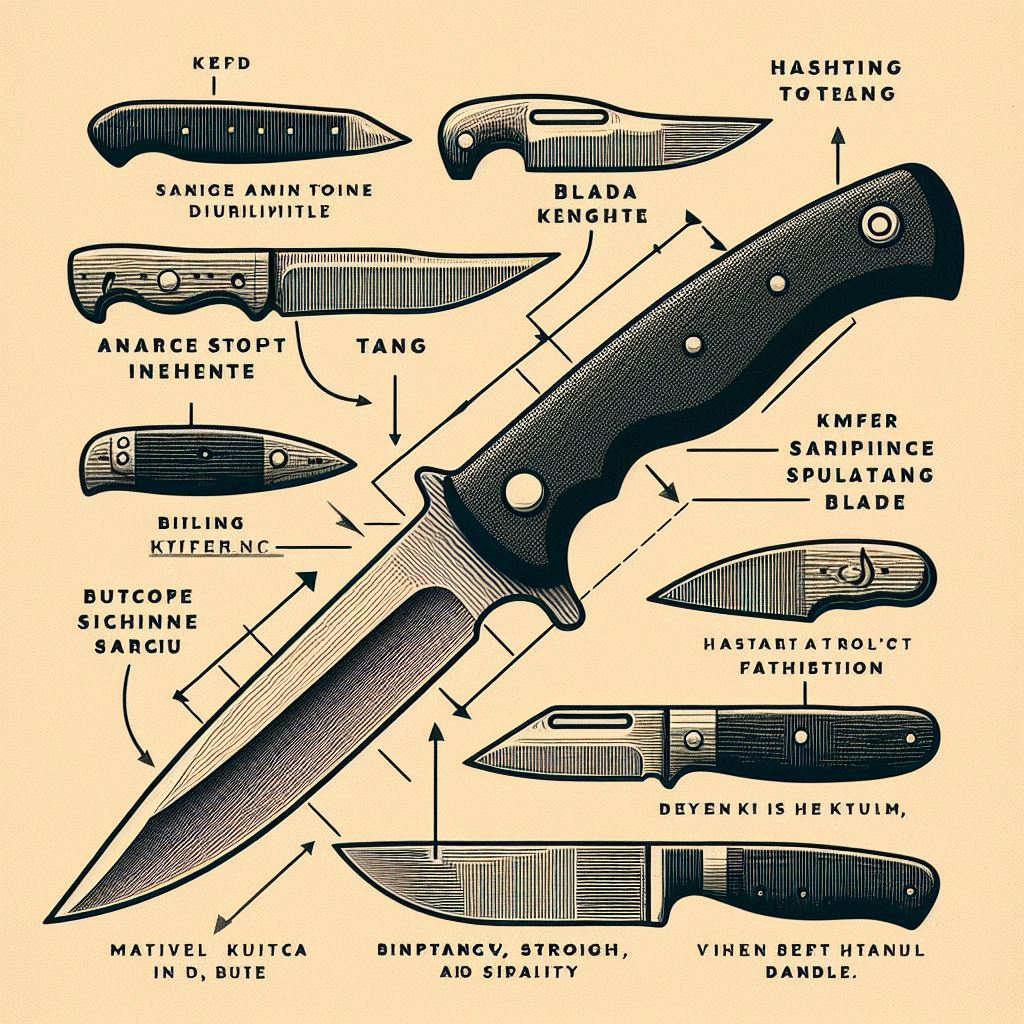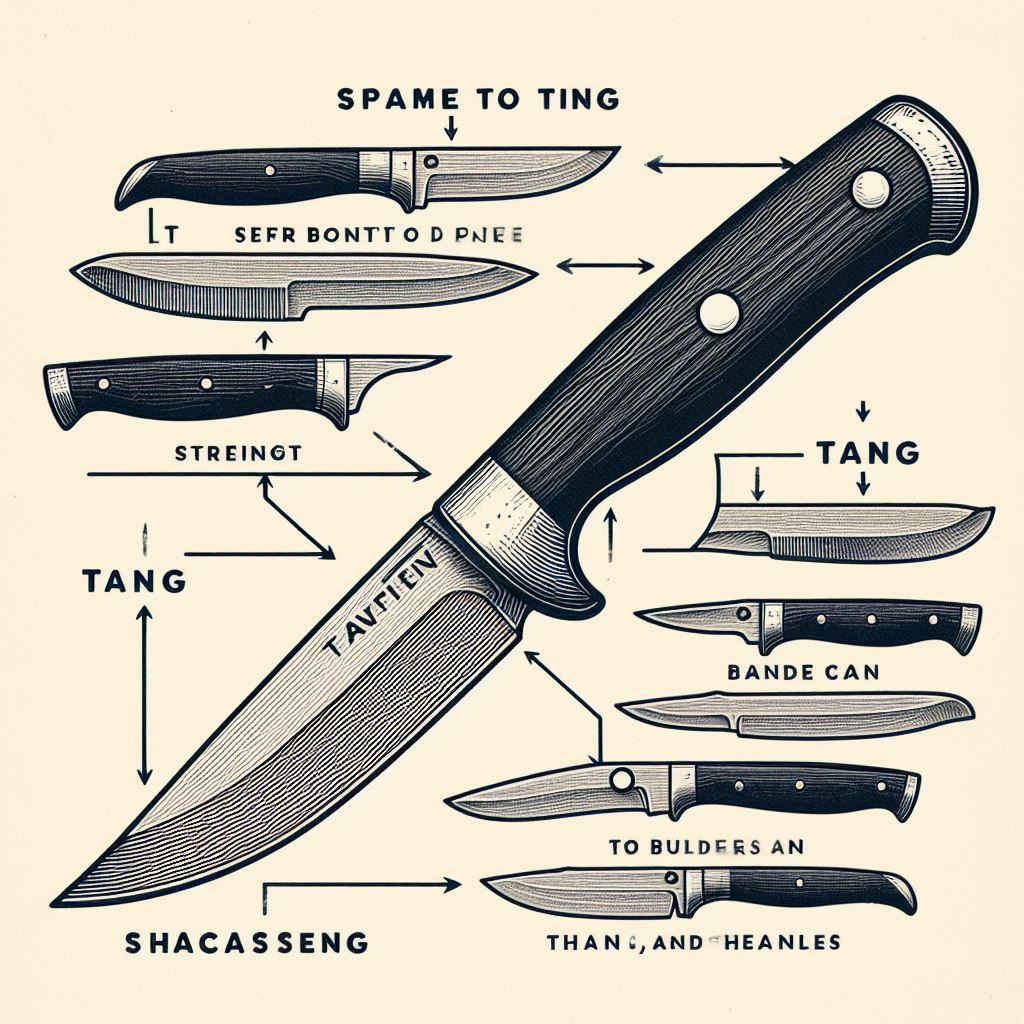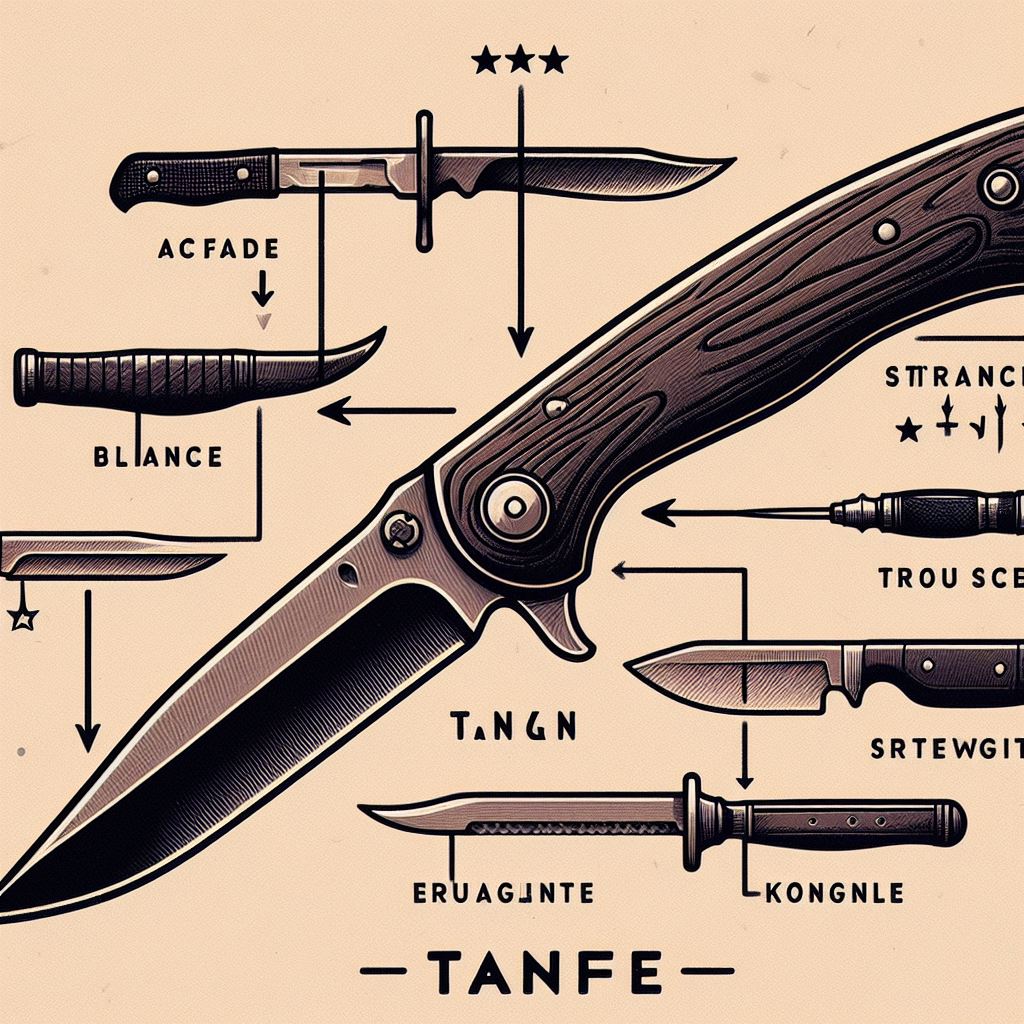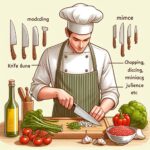The tang of a knife is the part of the blade that extends into the handle, providing balance and stability. Its importance lies in the overall durability and strength it offers to the knife.
Crafted for precision and reliability, the tang is an essential component of knife anatomy. It anchors the blade securely, ensuring the knife can withstand rigorous use. From kitchen prep to outdoor survival, the tang’s role is critical for safe and effective cutting tasks.
Manufacturers often describe their knives by the type of tang they incorporate, with full tang designs being the most desirable for heavy-duty applications. The tang’s design affects not only the knife’s longevity but also its handling and performance, making it a key factor to consider for anyone in the market for a quality blade. As core support for the knife, the tang’s design is a quintessential element in determining the overall value and functionality of this indispensable tool.

Introduction To The Anatomy Of A Knife
An introduction to the anatomy of a knife is crucial for understanding its functionality and design. A knife is not just a blade connected to a handle; it is a complex tool where each part plays a vital role. In this section, we will delve into what makes a knife more than just a cutting instrument by exploring its fundamental components, including a critical, yet often overlooked, element known as the tang.
Defining The Tang: The Backbone Of The Blade
The tang is the part of the knife that extends into the handle. It is not visible once the knife is assembled, but it is essential for stability and balance. Think of the tang as the knife’s backbone; it provides strength and supports the entire structure. There are different types of tangs, including full, partial, and stick, each offering various levels of balance and weight.
Components Of A Knife: Beyond The Blade And Handle
While the blade and handle are the most visible parts of a knife, there’s more to its anatomy. Here’s a breakdown of the components:
- Blade – The cutting part of the knife, made from materials like steel or ceramic.
- Edge – The sharpened side of the blade. Sharp edges make clean cuts.
- Spine – The blade’s back. It gives the blade thickness and durability.
- Tip – It is the end of the blade used for detailed work and piercing.
- Handle – Where you grip the knife. It can be made from wood, plastic, or metal.
- Bolster – A thick junction between the blade and handle for added balance.
- Rivets – The metal pins that secure the handle to the tang.
- Butt – The end of the handle. Sometimes it’s weighted for balance.
Understanding these components is key to recognizing quality craftsmanship in knives. It also aids in selecting the right tool for your culinary needs.
Understanding The Purpose Of A Knife Tang
The tang of a knife is the unsharpened extension of the blade that extends into the handle. It’s the backbone of the knife, providing strength, balance, and stability. It allows for a secure grip and can often be an indicator of the knife’s overall quality. Enthusiasts and professionals alike understand how crucial a well-crafted tang is for knife performance. Let’s dive into the various tang types and explore their roles in knife design.
Tang Types: Full, Partial, And Rat-tail
- Full Tang: The metal extends the full length and width of the handle, often visible on the sides. This type is synonymous with durability.
- Partial Tang: The metal partially extends into the handle. Lightweight and more affordable, but not as sturdy as full tang.
- Rat-tail Tang: Tapers down from the handle’s start and is threaded to attach the pommel. Common in swords but found in some knives.
The Role Of The Tang In Knife Durability
Knife durability hinges on tang construction. A full tang design ensures the knife can withstand forceful use without the handle detaching. In contrast, partial and rat-tail tangs command careful handling to maintain integrity. The tang type directly affects longevity and performance, especially under rigorous use.
How The Tang Affects Balance And Handling
The tang’s design impacts a knife’s balance, influencing precision and effort while cutting. A full tang knife feels balanced in the hand, requiring less effort to control. With a well-balanced knife, users can enjoy extended use with minimal fatigue. In contrast, knives with partial or rat-tail tangs might feel handle-heavy or blade-heavy. This mismatch can affect cutting technique and overall ease of use.
Understanding the tang is essential for selecting the right knife. Whether a chef or outdoorsman, choosing the right tang type means a better cutting experience.
The Tang’s Impact On Different Types Of Knives
The heart of a knife lies within its tang. This often-overlooked aspect is crucial for defining the knife’s durability, balance, and overall performance. Various knives boast different tang designs, each serving unique purposes and catering to the tool’s required strength, precision, and aesthetic value. Understanding the impact of the tang on different knives reveals much about their intended use and quality.
Culinary Knives: Precision And Control
In the realm of kitchen cutlery, the tang makes all the difference. Chefs and cooking enthusiasts alike rely on knives that allow for effortless control and precision.
- Full tang blades run the entire handle length, offering stability.
- Partial tangs are lighter but may lack in balance.
- Knives with hidden tangs blend the benefits of weight and control.
Culinary knives with a robust tang ensure consistent cuts and a comfortable grip, essential for intricate food preparation.
Outdoor And Tactical Knives: Strength And Toughness
For outdoor adventurers and tactical users, a knife must withstand rigorous use. Here, the tang determines survival tool robustness.
| Tang Type | Impact on Knife |
|---|---|
| Full tang | Optimal strength; suitable for heavy-duty tasks. |
| Partial tang | Good for light uses; may not endure high stress. |
A knife designed for outdoor use must possess a tough tang to perform effectively in demanding situations.

Artisanal And Specialty Knives: Aesthetic And Customization
When beauty marries function, you get artisanal and specialty knives. These pieces reflect personal taste and purpose.
- Rat-tail tangs offer a vintage look while maintaining fair strength.
- Tapered tangs give a sleek profile and comfortable balance.
- Custom tang shapes allow for unique aesthetics.
Collectors and enthusiasts appreciate knives that not only perform well but also boast distinctive craftsmanship and style.
Choosing The Right Tang For Your Needs
Selecting the proper tang for your knife is crucial for its functionality, balance, and lifespan. Whether you are a professional chef, an outdoor enthusiast, or a knife collector, understanding tang designs will guide you to the perfect knife choice.
Considerations For Professional Chefs And Culinary Enthusiasts
Professional chefs and culinary enthusiasts demand knives that balance precision and durability. When choosing, they should consider:
- Full tangs offer balance and weight, perfect for consistent chopping.
- Partial tangs are lighter, which could reduce fatigue during long prep sessions.
- Material quality ensures the tang withstands frequent use.
Tips For Outdoor Enthusiasts: Selecting A Survival Knife
For outdoor survival scenarios, the tang’s reliability is non-negotiable. Essential factors to consider include:
- Full tang designs provide strength for rigorous tasks like wood splitting.
- Handle comfort is vital to maintain grip in varied conditions.
- Materials resistant to corrosion secure longevity in harsh weather.
The Collector’s Perspective: When The Tang Makes A Difference
Kitchen tool collectors value tangs for authenticity and craftsmanship. Points to remember:
- Historic or culturally significant knives often feature unique tangs.
- Visible tangs can showcase the maker’s skill and the knife’s quality.
- Choose based on rarity, historical value, and the story behind the knife.
Maintaining Your Knife: Caring For The Tang
Understanding the tang of a knife is essential for its upkeep. The tang is the part of the blade that extends into the handle. It is crucial for balance and strength. Proper maintenance of the tang ensures your knife remains both safe and operational for years. In this section, we delve deep into the best ways to care for the tang of your knife.
Cleaning And Preventing Rust: Preserving The Integrity Of The Tang
A clean tang is vital for a durable knife. Rust can compromise the tang’s integrity. To avoid this:
- Always wipe the tang with a dry cloth after use.
- Use oil lightly on the tang to prevent rust.
- Avoid soaking knives in water which can cause rust.
Handling And Storage: Best Practices To Avoid Tang Damage
Correct handling and storage are key. For safekeeping:
- Use knife blocks or magnetic strips for storage.
- Ensure knives do not knock against each other; it can hurt the tang.
- Handle with care, avoiding dropping or bending the knife.
When To Seek Professional Knife Repair Or Restoration
Sometimes, a knife may need an expert touch.
- If the blade wobbles, the tang might be loose.
- Visible corrosion or rust might need a pro.
- For heirloom or high-value knives, seek professional care to maintain value.

Conclusion
Understanding the tang of a knife is crucial for chefs and enthusiasts alike. It ensures durability, balance, and safety in kitchen cutlery. Remember, a knife’s tang speaks volumes about its quality. Select wisely to enhance your culinary experience. Always consider tang when choosing your next kitchen companion.
Frequently Asked Questions On What Is The Tang Of A Knife And Why Is It Important
Why Is The Tang Of A Knife Important?
The tang of a knife provides balance and sturdiness, ensuring a strong, durable handle and better control during cutting tasks.
What Is The Purpose Of A Tang?
A tang is the part of a blade that extends into the handle, providing stability and strength to the tool or knife. It ensures a durable connection between the blade and handle for reliable use.
What Is The Tang Part Of A Knife?
The tang of a knife is the portion of the blade that extends into the handle, providing strength and balance to the overall structure.
Does A Knife Need To Be Full Tang?
A knife does not need to be full tang, but full tang construction often provides better balance and durability, especially for heavy-duty tasks.







